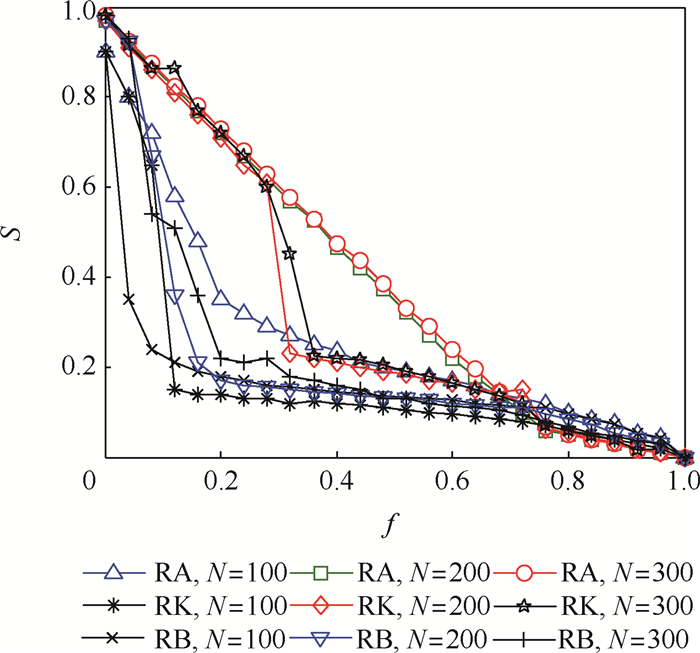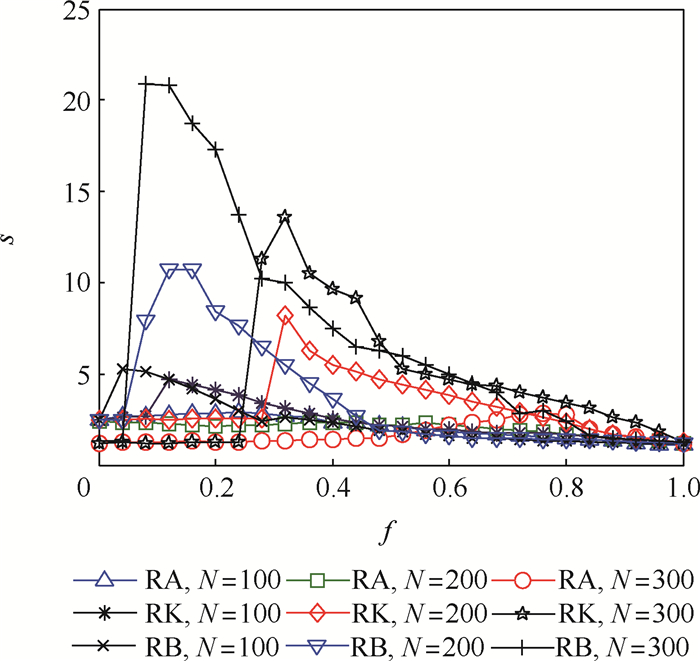-
摘要:
车载自组织网络(VANET)作为智能交通的重要基础应用,其安全稳定地运行是交通系统乃至社会经济可持续发展的需要。以最大连通度、连通分支平均规模、全局网络效率等参数为脆弱性测度指标,基于复杂网络理论,应用车辆仿真软件(VanetMobiSim)建立了VANET网络拓扑模型,详细研究了在随机攻击和蓄意攻击模式下脆弱性量化指标随节点移除比例的变化关系;通过仿真实验分析了节点密度、信号辐射半径及不同攻击策略对VANET脆弱性的影响。仿真结果表明:VANET在蓄意攻击下比较脆弱,基于节点介数的蓄意攻击效能最强;节点密度、信号辐射半径越小,VANET连通性越差,网络越脆弱。所提方法和结果为VANET拓扑控制优化和网络管理决策提供了理论依据。
-
关键词:
- 车载自组织网络(VANET) /
- 复杂网络 /
- 脆弱性 /
- 蓄意攻击 /
- 随机攻击
Abstract:As an important fundamental application of intelligent traffic system, the safe and stable operation of Vehicular Ad Hoc Network (VANET) is indispensable for the transportation system and even the sustainable development of social economy. The largest connected degree, average size of connected components and global network efficiency were used as the vulnerability evaluation metrics for VANET. Based on complex network theory, the VANET simulation model was established through vehicle simulation software (VanetMobiSim). Then, the relationship between the quantitative index of vulnerability and the node removal ratio under random attacks and intentional attacks was analyzed in detail. Furthermore, the influence of the density of nodes, signal radiation radius and patterns of attack on VANET vulnerability was analyzed by simulation experiment. The experimental results show that the VANET has a high vulnerability under intentional attacks; the intentional attacks based on node betweenness destroyed the networks most strongly. The smaller node density and signal radiation radius are, the worse VANET connected degree is and the more vulnerable the network is. The research methodology and results provide the theoretical basis for VANET topology control optimization and network management decision-making.
-
Key words:
- Vehicular Ad Hoc Network (VANET) /
- complex network /
- vulnerability /
- intentional attack /
- random attack
-
表 1 模型仿真参数
Table 1. Simulation parameters of model
参数 数值 信号辐射半径r/m 100, 200, 300 仿真区域面积/(m×m) 2 000×2 000 节点数目N 100, 200, 300 车道数 双向四车道 仿真时间/s 300 节点速度/(m·s-1) 5~20 -
[1] RASHEED A, GILLANI S, AJMAL S, et al. Vehicular Ad Hoc network (VANET): A survey, challenges, and applications[M]//LAOUITI A, QAYYUM A, SAAD M N M. Vehicular Ad-Hoc Networks for Smart Cities. Berlin: Springer, 2017: 39-51. [2] ZHANG H, LI J. Modeling and dynamical topology properties of VANET based on complex networks theory[J]. AIP Advances, 2015, 5(1): 017150. doi: 10.1063/1.4907245 [3] 张宏, 李杰. 车载自组织网络拓扑特性及控制[J]. 交通运输系统工程与信息, 2015, 15(2): 81-87. doi: 10.3969/j.issn.1009-6744.2015.02.013ZHANG H, LI J. Topological characteristics and control approach for VANET[J]. Transportation Systems Engineering and Information, 2015, 15(2): 81-87(in Chinese). doi: 10.3969/j.issn.1009-6744.2015.02.013 [4] ZHANG H, YAO Y G. An integrative vulnerability evaluation model to urban road complex network[J]. Wireless Personal Communications, 2019, 107(1): 193-204. doi: 10.1007/s11277-019-06248-7 [5] ELSADING M A, FADLALLA Y A. VANETs security issues and challenges: A survey[J]. Indian Journal of Science and Technology, 2016, 9(28): 1-8. [6] 张宏, 吕悦晶. 车载自组织网络信息流量特性分析[J]. 工程数学学报, 2017, 34(5): 449-457. doi: 10.3969/j.issn.1005-3085.2017.05.001ZHANG H, LV Y J. Information flow characteristics analysis of vehicular ad-hoc network[J]. Chinese Journal of Engineering Mathematics, 2017, 34(5): 449-457(in Chinese). doi: 10.3969/j.issn.1005-3085.2017.05.001 [7] TYAGI R, SHARMA N K, MALHOTRA K, et al. Comprehensive methodology for threat identification and vulnerability assessment in Ad Hoc networks[M]//BOKHARI M U, AGRAWAL N, SAINI D. Cyber security. Berlin: Springer, 2018: 335-347. [8] 冯慧芳, 李彩虹. 基于复杂网络的车载自组织网络抗毁性分析[J]. 计算机应用, 2016, 36(7): 1789-1792.FENG H F, LI C H. Invulnerability analysis of vehicular Ad Hoc network based on complex network[J]. Journal of Computer Applications, 2016, 36(7): 1789-1792(in Chinese). [9] FENG H F, LI C H, XU Y J. Invulnerability analysis of vehicular ad hoc networks based on temporal networks[C]//2016 2nd IEEE International Conference on Computer and Communications (ICCC). Piscataway: IEEE Press, 2016: 16867374. [10] SARIKA S, PRANVIN A, VIJAYAKUMAR A, et al. Security issues in mobile ad hoc networks[J]. Procedia Computer Science, 2016, 16(1): 217-222. [11] FU X W, YANG Y S, POSTOLACHE O. Invulnerability of clustering wireless sensor networks against cascading failures[J]. IEEE Systems Journal, 2019, 13(2): 1431-1442. doi: 10.1109/JSYST.2018.2849779 [12] KHAN Z, FAN P, FANG S. On the connectivity of vehicular ad hoc network under various mobility scenarios[J]. IEEE Access, 2017, 5: 22559-22565. doi: 10.1109/ACCESS.2017.2761551 [13] NAGHSHIN V. Modeling and analysis of wireless communications networks: Multi-tier cellular and ad hoc networks[D]. Canberra: University of New South Wales, 2017. [14] COOPER C, FRANKLIN D, ROS M, et al. A comparative survey of VANET clustering techniques[J]. IEEE Communications Surveys and Tutorials, 2016, 19(1): 657-681. [15] ALBERT R, JEONG H, BARABASI A L. Error and attack tolerance of complex networks[J]. Nature, 2000, 406(6794): 378-382. doi: 10.1038/35019019 [16] 冯慧芳, 李彩虹, 王瑞. 河谷型城市公交网络脆弱性研究: 以兰州市为例[J]. 交通运输系统工程与信息, 2016, 16(1): 217-222. doi: 10.3969/j.issn.1009-6744.2016.01.034FENG H F, LI C H, WANG R. Vulnerability study for public transport network of valley city: Case of Lanzhou[J]. Transportation Systems Engineering and Information, 2016, 16(1): 217-222(in Chinese). doi: 10.3969/j.issn.1009-6744.2016.01.034 [17] 朱云峰, 王艳军, 朱陈平. 不同攻击模式下中国航路网络抗毁性研究[J]. 南京工程学院学报(自然科学版), 2018, 16(2): 51-56.ZHU Y F, WANG Y J, ZHU C P. Research on the invulnerability of China's air route network under different attack strategies[J]. Journal of Nanjing Institute of Technology (Natural Science Edition), 2018, 16(2): 51-56(in Chinese). [18] 中华人民共和国住房和城乡建设部. 城市综合交通体系规划标准: GB/T 51328-2018[S]. 北京: 中国建筑工业出版社, 2018.Ministry of Housing and Urban-Rural Development of the People's Republic of China. Standard for urban comprehensive transport system planning: GB/T 51328-2018[S]. Beijing: China Architecture & Building Press, 2018(in Chinese). [19] HARRI J, FIORE M, FETHI F, et al. VanetMobiSim project[EB/OL]. (2016-09-21)[2019-03-01]. -








 下载:
下载:







